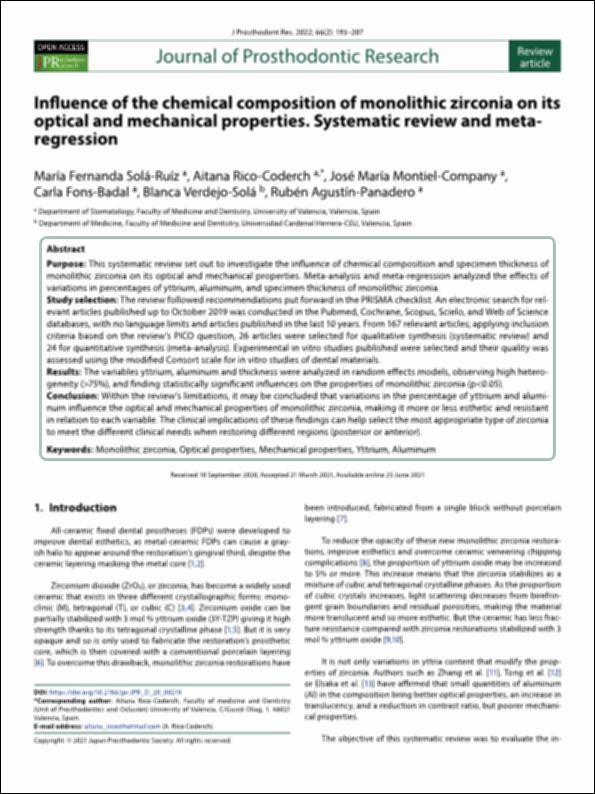Please use this identifier to cite or link to this item:
http://hdl.handle.net/10637/14419Influence of the chemical composition of monolithic zirconia on its optical and mechanical properties systematic review and meta-regression
| Title: | Influence of the chemical composition of monolithic zirconia on its optical and mechanical properties systematic review and meta-regression |
| Authors : | Solá Ruíz, María Fernanda Rico Coderch, Aitana Montiel Company, José María Fons Badal, Carla Verdejo Solá, Blanca Eugenia Agustín Panadero, Rubén |
| Keywords: | Zirconium - Optical properties.; Zirconium - Mechanical properties.; Circonio - Propiedades mecánicas.; Circonio - Propiedades ópticas. |
| Publisher: | Japan Prosthodontic Society |
| Citation: | Solá-Ruíz, M. F., Rico-Coderch, A., Montiel-Company, J. M., Fons-Badal, C., Verdejo-Solá, B. & Agustín-Panadero, R. (2022). Influence of the chemical composition of monolithic zirconia on its optical and mechanical properties: systematic review and meta-regression. Journal of Prosthodontic Research, vol. 66, i. 2 (apr.), pp. 193–207. DOI: https://doi.org/10.2186/jpr.JPR_D_20_00218 |
| Abstract: | Purpose: This systematic review set out to investigate the influence of chemical composition and specimen thickness of monolithic zirconia on its optical and mechanical properties. Meta-analysis and meta-regression analyzed the effects of variations in percentages of yttrium, aluminum, and specimen thickness of monolithic zirconia. Study selection: The review followed recommendations put forward in the PRISMA checklist. An electronic search for relevant articles published up to October 2019 was conducted in the Pubmed, Cochrane, Scopus, Scielo, and Web of Science databases, with no language limits and articles published in the last 10 years. From 167 relevant articles; applying inclusion criteria based on the review’s PICO question, 26 articles were selected for qualitative synthesis (systematic review) and 24 for quantitative synthesis (meta-analysis). Experimental in vitro studies published were selected and their quality was assessed using the modified Consort scale for in vitro studies of dental materials. Results: The variables yttrium, aluminum and thickness were analyzed in random effects models, observing high heterogeneity (>75%), and finding statistically significant influences on the properties of monolithic zirconia (p<0.05). Conclusion: Within the review’s limitations, it may be concluded that variations in the percentage of yttrium and aluminum influence the optical and mechanical properties of monolithic zirconia, making it more or less esthetic and resistant in relation to each variable. The clinical implications of these findings can help select the most appropriate type of zirconia to meet the different clinical needs when restoring different regions (posterior or anterior). |
| Description: | Este artículo se encuentra disponible en la siguiente URL: https://www.jstage.jst.go.jp/article/jpr/66/2/66_JPR_D_20_00218/_pdf/-char/en Este artículo de investigación pertenece al número especial "Advances in Personalized Nursing Care". |
| URI: | http://hdl.handle.net/10637/14419 |
| Rights : | http://creativecommons.org/licenses/by-nc/4.0/deed.es |
| ISSN: | 1883-1958 1883-9207 (Electrónico) |
| Language: | es |
| Issue Date: | 10-Apr-2022 |
| Center : | Universidad Cardenal Herrera-CEU |
| Appears in Collections: | Dpto. Odontología |
Items in DSpace are protected by copyright, with all rights reserved, unless otherwise indicated.


